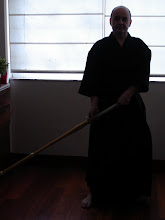What I would like to do today is use the basic idea of a correct kamae that everyone knowns as a base and add to that my ideas about how you can improve your kendo.
The very first thing to think about is your gaze. Never divert your gaze.
Point: Don’t divert your gaze from your opponent.
Within kendo there are many teachings regarding how to look at your opponent, for example “Enzan no metsuke” (to look at a distant mountain) which says that you should look at the entirety of your opponent. However, if you approach looking at your opponent in such a vague manner your gaze can become easily diverted. So what I do in my keiko is look directly at my opponents eyes and never divert my eyes from them.
Why do I do this?
Well, depending on where you are looking at your hands may move up, and this may cause your kensen’s pressure (seme) to disappear. This is why I say the first important point to think about in kendo is to never divert your gaze from the opponent’s eyes.
The next point regarding kamae I wish to make is that you should lower your kensen as much as you can in order to pressure your opponent.
Point: When in kamae, lower your kensen and push your hands out a little bit in front of your body.
Another point is to push your hands out a little bit in front of your body and move them (and the shinai) in front of your body.
Yet another point is to never break your body posture.
What should we pay attention to in order not to do this?
Well, the first thing is the point about never diverting your gaze we mentioned before.
Secondly, you should pay attention to your spine and your coccyx.
Point: Paying attention to your spine and coccyx, straighten your back.
Depending on how consciously you approach this your body posture will not break.
You should always pay attention to this when you move.
Another point is your legs.
The foundation of everything is of course your legs, especially your left leg.
I personally think that the biggest problem in kendo today is bad footwork.
Basic kendo states that should move with the front foot. Basic kendo states that should move with the front foot. However, nowadays I see a lot of kendoka, children and adults, bring up the left foot first then strike. What you should do is strike without bringing your left foot first up.
Point: From your kamae strike without pulling your left foot first.
You should kamae in such a way that you can strike at any point, even if you are moving. This is what I pay attention to in my kendo.
If you tense up your shoulders like this then your hands will also tense up and you will be unable to put power into the monouchi (striking) section of your shinai. Therefore, relax your shoulders.
Point: Grip the shinai firmly and relax your shoulders.
You can do this by moving your shoulder blades back and dropping them. However, you shouldn’t relax your grip, rather grip the shinai firmly to a certain extent. When in kamae try to imagine relaxing from your shoulders down to your elbows.
I hope that this has been useful to everyone, and I hope you try the points mentioned here at least once.
Point: Don’t divert your gaze from your opponent. Lower your kensen.
Pay attention to your spine down to your coccyx and straighten your back.
If you move your shoulder blades a little bit back and down then you will be able to relax your shoulders.
Toru KAMEI Sensei’s Kendo Lecture
The text of this note is an excerpt of DVD> Toru Kamei's Kendo Improvement Course () Book – 2017/6/1 Toru Kamei (Author) and Toru Kamei's Kendo Improvement Course () Book – 2017/6/1
Registration information
Release date: 2017/6/1
ISBN-10: 4884584074
ISBN-13: 978-4884584078
Publisher: Physical Education and Sports Publisher (2017/6/1)





No hay comentarios:
Publicar un comentario